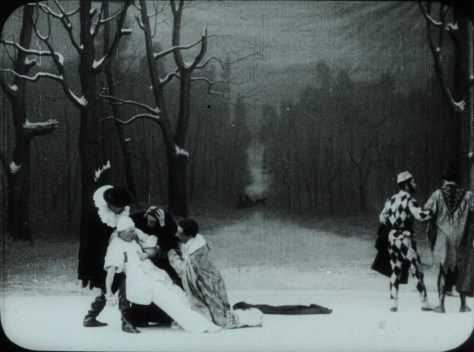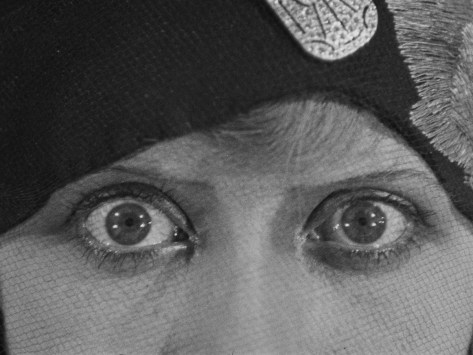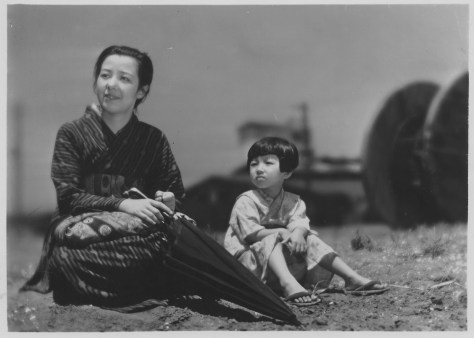It was auteur day at Pordenone, with works by three silent master-directors scattered nonchalantly through the programme: Ozu, Murnau and Dreyer. But auteurism is anachronistic to silent cinema and anathema to many early film aficionados, so fittingly some of my favourite screenings today fell far from the canon.

One of the best things I saw all week was Valentine Robert’s presentation of Tableaux Vivants in the early cinema strand. This was something very special indeed – like a video essay, but more expansive. The idea was simple: popular paintings were projected on screen before early films that mimicked their compositions. The effect was spectacular though, and very illuminating about narrative and visual culture in the early film period. As this presentation made clear, many narrative films at this time were also adaptations of images associated with historical, literary and biblical narratives, rather than the story themselves. Or both, at least. Erotic films too, as you might imagine, took their cues from paintings and sculptures. The care and detail in this presentation was very impressive and all served the argument beautifully. All this as well as Stephen Horne’s gorgeous accompaniment for a long, and very varied presentation, comprising 30-plus films and many more art works.
The double-bill of German films this afternoon featured some very familiar names. First there was Der Golem. No, not the 1920 one, but the 1915 original, long thought almost entirely lost. The bad news is that it is still lost, but some more fragments have been discovered and spliced together with titles to form something that is not really a film, but rather a suggestion of one. In this kinda prequel Paul Wegener’s clay man comes to life brilliantly and with just the most tender and slender of movements. Other scenes reinforce the sense that James Whale’s Frankenstein would be nothing without this silent-era antecedent. Utterly fascinating.

Der Golem was followed by an early Murnau movie starring Conrad Veidt. Can’t go wrong, right? Wrong. The mighty Veidt is mesmerising as ever in Der Gang in die Nacht (1920), even if he was posed halfway between his own Cesare in Caligari and Murnau’s future Orlok in Nosferatu. The lighting and composition of each scene was immaculate, and the acting a masterclass in Expressionist emoting, but all the characters were mysteries to themselves and each other. This tale of temptation, adultery, heartbreak and blindness made little emotional sense, if any. File under: curios, cheekbones and couldabeens.

Today was a good day: I also saw some mischievous shorts in the Nasty Women strand, on the theme of identity change. I particularly enjoyed the native American woman trying on a new style in An Up-To-Date Squaw (1911) – which links us neatly to the European Western strand, which links us neatly once again to the big screening of Thursday, which was La Femme Revée, directed by none other than Jean Durand in 1928. This ultra-glam romantic drama starred Alice Roberts (yes the Countess in Pandora’s Box) as a Spanishwoman, Mercedes, chafing at her role as a society wife to Angel (Charles Vanel again) and flirting with a sexy dance instructor. Some stunning images in this. The extended dance routine was very special, with high-kicking pyjama-clad chorus lines and arm-to-floor-tassels, but some very dangerous-looking stair work. I also enjoyed Mercedes and her dance instructor practising in front of a mirror, shot from a high angle, and the climactic sequence that involved an emergency cattle drive across a river in a thunderstorm. Despite all these gems, the film was a bit slow and too long, but but somehow also worth every second of its running time.
Is Roberts/Roberte better in Pandora’s Box than she is here? Yes, and more glamorous too, actually, but it’s ever so good to see her in a lead role. I had only ever seen her as the Countess before.

But we began with Ozu. The film, An Inn in Tokyo (1935) may have been familiar but I have never seen it this way before and perhaps will not again. As part of this year’s teaser for a full Saundo-Ban strand in 2018, we saw the film with its original release soundtrack. This was just music, rather than the sound effects we heard with An Island Girl, and it was sparse too – with plenty of silence, which allowed us to deeply inhale this emotionally devastating, brilliantly realised film. The story of a single father, out of work, with two children, who sabotages his chance of future happiness and stability by falling in love with a woman in a similar situation would be heavy melodrama in anyone else’s hands. Here, even when our hero is less than heroic, it is delicately done, with pinpricks of emotional pain accumulating in heartbreak.
Yes, I may have sardonically remarked that this film proves that even at a man’s lowest ebb, he can still console himself by passing judgment on women. Well, such a comment is true to the facts of the case, ma’am, but that’s not how this drama feels. From the excellent child actors, to the quiet dignity of the adults, each of whom has a cross to bear, this is perfectly nuanced and timeless stuff. Ozu shows us that imperfect people deserve our sympathy, respect and compassion too. I hope he never goes out of fashion
I promised you Dreyer, yes? Well I wimped out of The Bride of Glomdal (1926) due to tiredness, familiarity, wine and the desire to catch up with Pordenone pals before they skip town. I saw just enough to know that John Sweeney was going to do it justice, and the film is luscious as ever. As is this festival, which seems to be riding a high this week. Just two more days to go …
- Intertitle of the day: “This life of leisure overwhelms me.” You and me both, Mercedes. That’s from La Femme Revée of course.
- Persistent theme of the week: blindness and eye surgery. Erm, I’d really rather not, if at all possible, thanks.
- What-the-heck moment of the day: your humble scribe got a mention from the stage today, and I wasn’t there to see it, as I was answering work emails somewhere else. Thanks to those who let me know!
- Pinup of the day: it has to be Tony D’Algy as the thrown-over childhood sweetheart in La Femme Revée. Jean Durand has a good eye for a cattle-man.
- Visit the Giornate del Cinema Muto website

Another great recap. Sorry that the Veidt was not worthy of him not Murnau. I will watch anything for his eyes (and cheekbones). A big fan of Ozu here, so this is on the want to see. We’ll see if Anita programs it in SF. Although I can name 10 other films from this season at Pordenone I would love to see at The Castro (no fun for you however with repeats when you visit next)